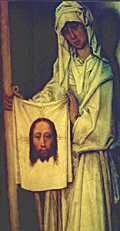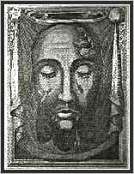| Home/Portal |
| Site Menu |
 |
| Mandylion |
| Shroud |
| Saints |
| Medal |
| Prayers |
| Gallery |
| Links |
| My Chaplet |
 |
| The Mandylion |
 |
The
Holy face of Jesus from Veronica's Veil in the Basilica of St. Peter in the Vatican |
| St.
Veronica Feast Day 12th July |
||
There is no biblical record of Veronica, but a tradition developed in the Church surrounding a woman whose name, Veronica, is made up from the Latin word 'vera' and the Greek word 'icon', meaning together 'true likeness'. The story of Veronica is immortalised in the 6th Station of the Cross.
The
story of Veronica As an everlasting memorial of this kind act, the Saviour imprinted the image of his Holy Face on her Veil. This Veil has been treasured by Christians ever since, and has been found to have mysterious, miraculous powers to heal sickness and to convert unbelievers. |
||
The
Veil itself became known as 'the Veronica', and a physical object
called 'the Veronica' is kept in Vatican. It was first seen in Rome
in the eighth century, and was installed in the Vatican in 1297.
| ||
| However, this veil may well be a 'copy' of a previously known 'true likeness' of the Holy Face called the 'Mandylion'. | ||
There
are 'copies' and 'copies'...! |
||
A
further possibility, however, is that the image on the Veronica
was itself mysteriously transferred to the 'veil' whilst that cloth
was in the presence of the Mandylion. The Mandylion image was apparently
capable of transferring itself in this mystical way to clay tiles,
wooden panels, cloth, etc., which were placed or remained near it. |
||
Confusion
surrounding the Veronica
It is known that in the early centuries of Christianity there were several holy images purporting to be the 'true likeness' doing the rounds, and this confuses the issue. The official line of the Catholic church is that the Veil in the Vatican is the original image of the Holy Face imprinted on the veil Veronica offered to Jesus. Catholic Online web site gives the following account of Veronica and the veil: |
||
|
||
| Stations
of the Cross |
||
